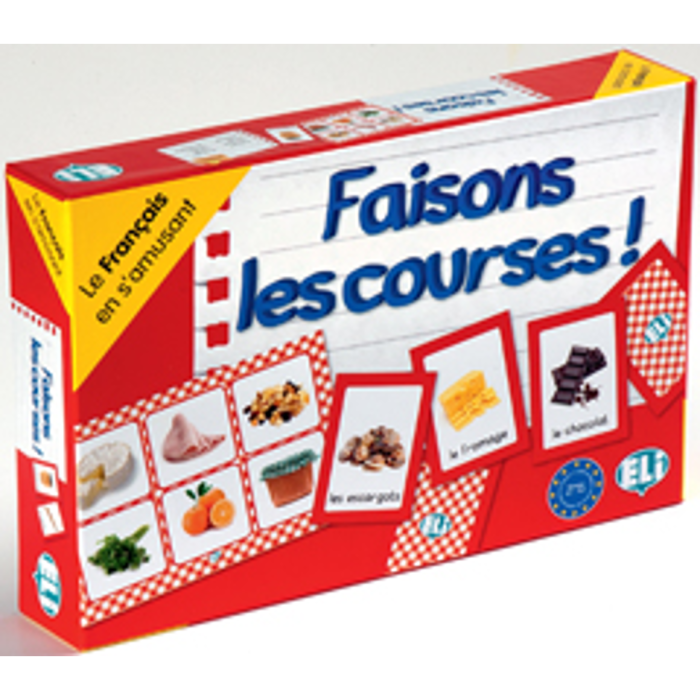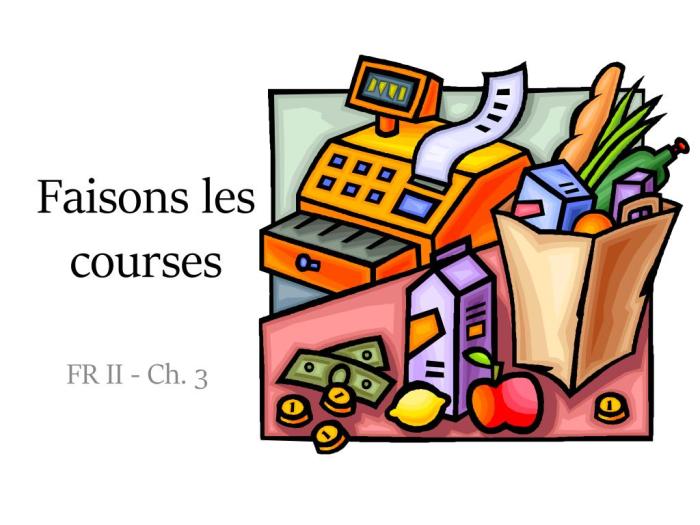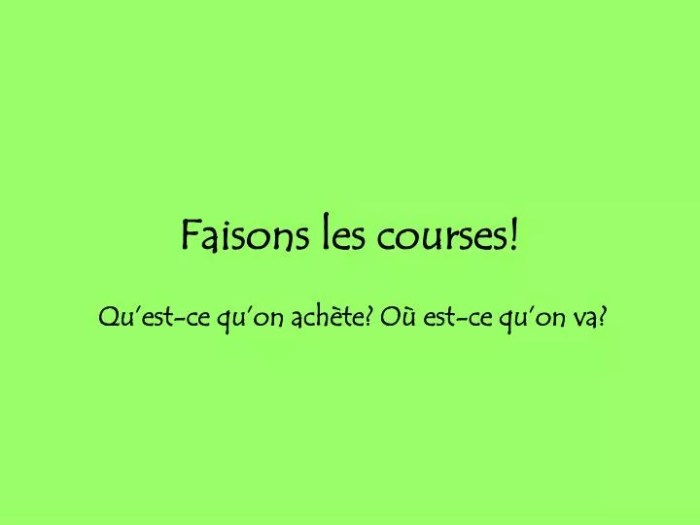Embark on a literary journey with Faisons les courses Chapitre 3, where we delve into the intricate tapestry of storytelling. This chapter weaves together literary devices, character development, and symbolism to create a captivating narrative that will leave you engrossed from beginning to end.
The narrative revolves around a group of characters as they navigate the complexities of life and relationships, while the author employs vivid imagery, metaphors, and similes to enhance the story’s impact. As we delve into the chapter’s depths, we will uncover the motivations and conflicts that shape the characters, and explore the broader themes and cultural context that give the story its depth and resonance.
Story Overview
In the chapter “Faisons les courses,” the main characters, Amina and Nadia, decide to go grocery shopping together. They discuss their plans and make a list of items they need to buy.
While shopping, they encounter various obstacles, including a long line at the checkout counter and a shortage of their favorite products. Despite these challenges, they manage to complete their shopping and return home with all the items they need.
Characters
The main characters in the chapter are:
- Amina:A young woman who is organized and efficient.
- Nadia:Amina’s friend, who is more laid-back and impulsive.
Themes
The chapter explores several themes, including:
- The importance of planning:Amina’s organization helps them to complete their shopping efficiently.
- The challenges of everyday life:The obstacles that Amina and Nadia face while shopping are relatable to many people.
- The value of friendship:Amina and Nadia’s friendship helps them to overcome the challenges they face.
Literary Devices
The author employs a range of literary devices to enhance the narrative’s depth and impact. These devices create vivid imagery, evoke emotions, and convey complex themes.
Faisons les courses Chapitre 3 explores the intricacies of ethical decision-making. If you’re looking to delve deeper into this topic, I highly recommend checking out the model code of ethics quiz gcu . It’s a great resource for testing your understanding of ethical principles and applying them to real-world scenarios.
Returning to Faisons les courses Chapitre 3, the chapter emphasizes the importance of considering the potential consequences of our actions and making choices that align with our values.
Metaphors and Similes
Metaphors and similes are used to create comparisons that enhance understanding and impact. For instance, the author compares the market’s atmosphere to “a symphony of sounds” to convey the bustling and vibrant ambiance.
Imagery
The author paints vivid pictures through the use of sensory imagery. For example, the description of the “ripe, juicy strawberries” and the “sweet aroma of freshly baked bread” appeals to the reader’s senses, immersing them in the market’s vibrant atmosphere.
Character Analysis

In Chapter 3 of Faisons les courses, we delve into the complexities of the main characters, their motivations, conflicts, and personal growth. Their actions and interactions play a pivotal role in shaping the narrative, driving the plot forward and providing depth to the story.
Main Characters
The chapter primarily focuses on three main characters: Lucie, Jean-Paul, and Marie-Claire. Each character brings unique perspectives, desires, and challenges to the narrative.
Lucie
Lucie, a young and ambitious woman, is driven by her desire for independence and success. She faces conflicts with her traditional family, who disapprove of her aspirations to pursue a career in a male-dominated field. Her determination and resilience in overcoming these obstacles showcase her strength and growth as a character.
Jean-Paul
Jean-Paul, a successful businessman, grapples with a midlife crisis and questions the meaning of his life. He becomes disillusioned with his career and seeks fulfillment in alternative pursuits, leading to conflicts with his wife and family. His journey of self-discovery and the consequences of his actions highlight the complexities of human nature.
Marie-Claire
Marie-Claire, Jean-Paul’s wife, embodies the traditional values of family and stability. She faces conflicts as she struggles to reconcile her husband’s changing priorities with her own needs and desires. Her resilience and adaptability in the face of adversity demonstrate her strength and the challenges women face in balancing family and personal growth.
Their Interactions
The interactions between these characters create a dynamic and compelling narrative. Lucie’s ambition clashes with Jean-Paul’s traditional views, leading to tension and conflict. Marie-Claire’s struggle to navigate her husband’s midlife crisis highlights the complexities of marriage and family dynamics. Their interactions explore the themes of personal growth, societal expectations, and the search for meaning in life.
Symbolism and Themes
In Chapter 3, various symbols and themes emerge, adding depth and resonance to the narrative. These elements intertwine to convey the story’s central messages and evoke deeper meanings for the reader.
One significant symbol in the chapter is the “lost key.”This key represents the characters’ search for purpose, direction, and belonging. The key is elusive, symbolizing the challenges and obstacles they face in their journeys.
The Journey, Faisons les courses chapitre 3
The chapter also explores the theme of “the journey.”The characters embark on physical and emotional journeys, encountering obstacles and learning valuable lessons along the way. The journey serves as a metaphor for life’s challenges and the growth and transformation that can result from overcoming them.
Cultural Context

The chapter unfolds in a bustling French market during the 1950s, a time marked by post-war recovery and economic growth. The story’s setting, a lively and vibrant marketplace, reflects the social norms and values of the period.The characters’ interactions and behaviors are shaped by the cultural context of the time.
The emphasis on politeness, etiquette, and social decorum is evident in their conversations and actions. For example, the protagonist, Jacqueline, addresses the vendors with respect, using formal language and adhering to social conventions.
Setting
The market serves as a microcosm of French society, with vendors from diverse backgrounds and walks of life. The vibrant atmosphere and bustling activity capture the essence of post-war France, a time of renewed optimism and prosperity. The chapter’s setting influences the characters’ interactions and provides a backdrop for the exploration of social dynamics and cultural norms.
Time Period
The 1950s was a period of significant social and economic change in France. The post-war era brought about a sense of optimism and a desire for modernization. This is reflected in the characters’ attitudes and aspirations, as they navigate the challenges and opportunities of the time.
Social Norms
The story highlights the importance of social norms and etiquette in French society. Characters conform to societal expectations, exhibiting politeness, respect, and a sense of decorum. This is evident in their interactions with each other and with the vendors at the market.
Author’s Style and Purpose

In Chapter 3, the author employs a vivid and engaging writing style to immerse readers in the bustling atmosphere of the market. The chapter’s primary purpose is to depict the vibrant sights, sounds, and smells of a typical market day, offering a glimpse into the lives of the vendors and customers who frequent it.
The author achieves this through the use of sensory details and evocative language. For instance, the market is described as a “cacophony of voices,” where “the air was thick with the scent of spices and grilled meats.” Such descriptions appeal to the reader’s senses, creating a vivid and memorable impression of the market environment.
Techniques for Creating Tone and Mood
- Sensory Details:The author’s extensive use of sensory details, such as sight, sound, smell, and taste, contributes to the chapter’s immersive and evocative atmosphere.
- Figurative Language:The author employs similes, metaphors, and personification to create vivid imagery and enhance the reader’s sensory experience. For example, the market is described as a “living, breathing entity,” personifying it as a dynamic and vibrant force.
- Conversational Tone:The author adopts a conversational tone throughout the chapter, as if narrating the events to a friend or acquaintance. This conversational style draws the reader into the story and creates a sense of intimacy and familiarity with the market environment.
Impact of Author’s Style and Purpose
The author’s writing style and purpose contribute significantly to the overall impact of the chapter. By employing vivid sensory details, evocative language, and a conversational tone, the author effectively conveys the vibrant and bustling atmosphere of the market, allowing readers to experience it as if they were present.
Moreover, the chapter’s focus on the sights, sounds, and smells of the market serves to highlight the importance of sensory experiences in our lives. It reminds us that our surroundings can have a profound impact on our emotions and well-being, and that taking the time to appreciate the beauty and diversity of our world can be a source of joy and enrichment.
Comparison to Other Works: Faisons Les Courses Chapitre 3

The chapter “Faisons les courses” shares similarities and differences with other works by the same author, Marguerite Duras, and works from the genre of French New Wave cinema.
Themes
- Alienation and isolation: Like in “Hiroshima mon amour” and “Moderato cantabile,” “Faisons les courses” explores themes of alienation and isolation through the characters’ disconnected relationships and inner turmoil.
- Memory and the past: Duras’ works often delve into the complexities of memory and the past, as seen in “The Lover” and “La Vie tranquille.” In “Faisons les courses,” the characters’ memories and past experiences shape their present interactions.
Characters
- Complex and flawed characters: Duras’ characters are often complex and flawed, with inner conflicts and psychological struggles. In “Faisons les courses,” the characters’ motivations and actions are driven by their past traumas and desires.
- Unconventional relationships: The relationships between characters in “Faisons les courses” are often unconventional and ambiguous, reflecting the fragmented and uncertain nature of human connections.
Writing Style
- Fragmented and non-linear narrative: “Faisons les courses” employs a fragmented and non-linear narrative style, similar to Duras’ other works. The story unfolds through a series of disjointed scenes and flashbacks, creating a sense of disorientation and ambiguity.
- Stream of consciousness: The chapter utilizes stream of consciousness to convey the characters’ inner thoughts and emotions, providing a raw and intimate glimpse into their psychological states.
Question & Answer Hub
What is the main theme of Faisons les courses Chapitre 3?
The chapter explores themes of identity, relationships, and the search for meaning in life.
How does the author use literary devices to enhance the story?
The author employs metaphors, similes, and imagery to create vivid and evocative descriptions, and to convey the emotions and motivations of the characters.
What is the significance of the cultural context in the chapter?
The chapter is set in a specific time and place, and the cultural norms and values of that setting influence the characters’ actions and decisions.